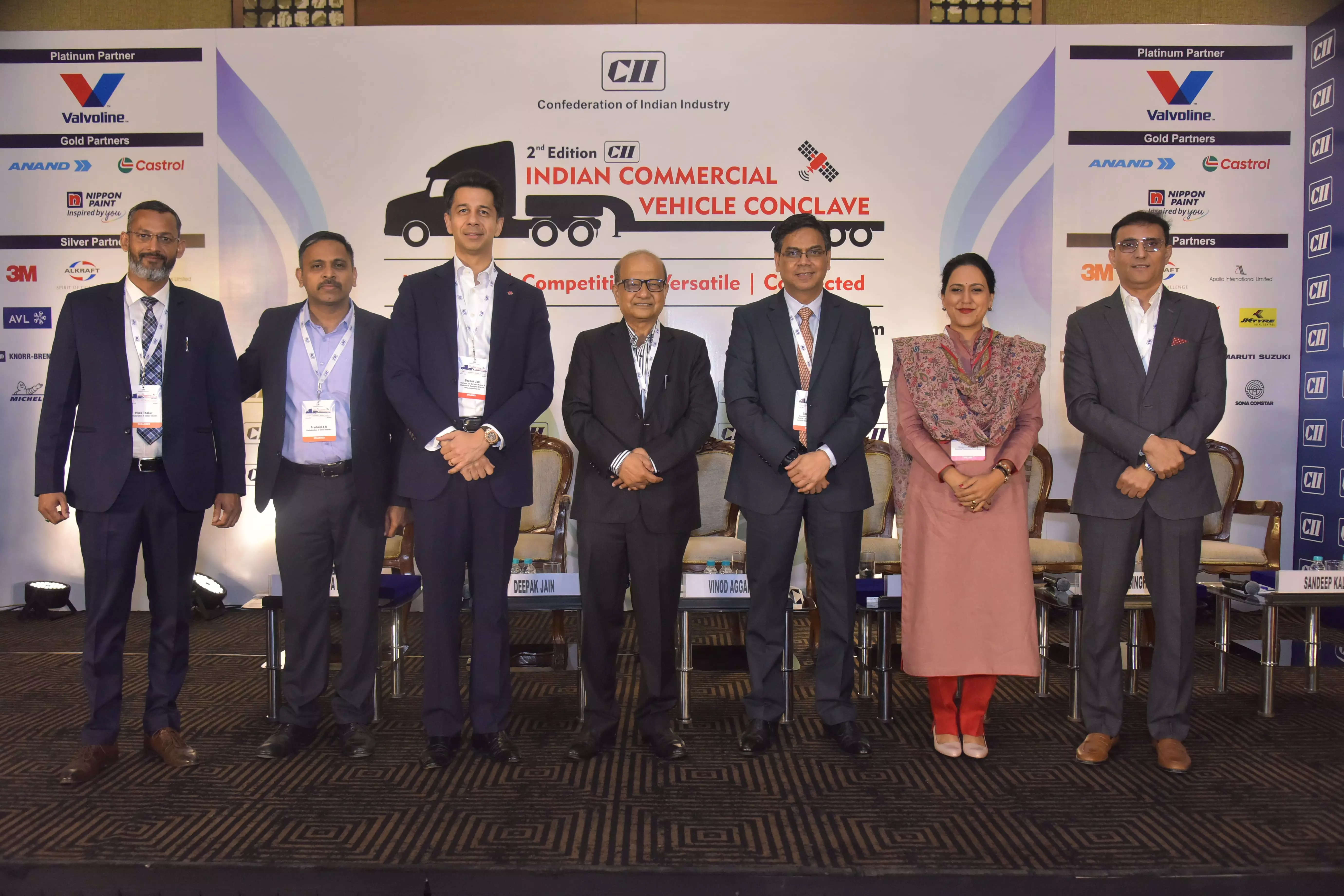
New Delhi: The commercial vehicle (CV) industry, often referred to as the backbone of the national economy, is going through a big transformation driven by the technology mega trends. This transition, as part of the global automotive industry changes, is happening in areas of alternative fuels, electrification, connected and autonomous technologies, and industry modernisation.
The CV market, which accounts for about 4% of India’s total domestic automotive production volumes, is expected to grow at a CAGR of about 8% by 2028. Karnataka, Madhya Pradesh, Tamil Nadu (TN), Maharashtra, and Uttarakhand are the major CV manufacturing states in India, with TN accounting for the highest volumes.
Exponential growth in online retailing, new product introductions, logistics services and expanded network of improved highways along with implementation of BS-VI norms have bolstered growth in the commercial vehicle market in India, according to industry experts at the recent ‘Indian Commercial Vehicle Conclave’, organised by the Confederation of Indian Industries (CII).
Girish Wagh, Executive Director, Tata Motors, said the CV industry is going to be an important partner and will drive the growth of India to one of the major global economies.
Vinod Aggarwal, CEO, VECV, and President, SIAM, said that as our economy is currently at USD 3.5 trillion, it is expected to go up to USD 5-7 trillion in the next 5-7 years. “If the economy moves ahead at this rate, the future of the CV industry is bright. It will not be a linear growth. There will be ups and downs. But in the next five to seven years, this industry is poised to double its size,” he said.
Globally, the CV industry is cyclical in nature, and India is no exception. The domestic CV industry crossed the 1 million volume mark in FY19. While it is yet to clock the pre-COVID volumes, the industry is showing promising signs of growth.
Alternative Fuels and Electrification
Experts suggest that alternative fuels and electrification will drive the way towards decarbonisation in the CV industry. “During last year, CNG accounted for about 35%-40% of light and medium duty trucks sales. Even though the prices may fluctuate impacting sales, in the longer run the potential of the CNG fuel is extremely high. For long haulage trucks, LNG is going to be very important. Various pilot projects have shown that the fuel efficiency offered by the LNG trucks is better than the diesel trucks. A lot of work is going on for LNG distribution. We need fuel stations for LNG and it needs special storage,” Aggarwal said.
He said that there is a lot of potential for electric buses as well. However their sales to STUs are currently a challenge, owing to the payment security mechanism business model.
Deepak Jain, Chairman, CII Northern Region and Chairman & Managing Director, Lumax Industries, said that with electrification, we need localization of sensors and electronic components as well. “Although there is some policy framework, we do lag behind certain Asian and competing economies on these terms.”
According to Sandeep Kalia, Managing Director, Valvoline Cummins, hydrogen could also serve as a good option for heavy-duty long haulage vehicles with diverse duty cycles.
Connected, autonomous, and modernised
Aggarwal of VECV stated that one of the major transformations in the CV industry has been safety standards in terms of implementing ABS, roof and cabin crash norms, roll over safety for buses, fire related norms, and improving the power to weight ratios.
Another major transformation, he said, is modernisation, including the mandate for air conditioned cabins for drivers. “If we want the productivity of drivers to be better, they need to be comfortable.”
Anjali Singh, Executive Chairperson, Anand Group and Chairperson, CII Haryana, said, “In the upcoming years, the CV industry is likely to register faster growth in the BRIC countries, and emerging markets like Asia, Africa and Latin America. While these markets demand high reliability, they have limited interest in comfort features for the heavy-duty vehicles. We in India must change this mindset, and aim to offer more features while ensuring reliability and cost competitiveness.”
Wagh of Tata Motors stated that connectivity has the potential to bring in significant benefits, especially for the CV fleet owners in the areas of delivering better service to the end customer, improving fleet utilization and overall productivity improvement. “We are already witnessing a significant traction for connectivity features post the BS-VI transition,” he said.
While autonomous is fast becoming prevalent in mature markets, Wagh noted that for India it is likely to be focused more on improving road safety as well as driving comfort with the intelligent use of ADAS features.
Aggarwal believes that with connected trucks, productivity can be taken to “extremely high levels.” We can provide predictive maintenance services, and as fuel accounts for 50% of the cost of ownership, fuel efficiency-related performance can also be improved by tracking the driver behaviour.
Need for collaboration
Anjali Singh said, “As we work together to build out the CV sector, new businesses and operating models will require close integration of both manufacturing and the supply chain. Organizations would need to map key technology solutions as critical enablers to achieve their strategic goals and absorb shocks from future events of a similar nature or any other kind.”
India is a cost sensitive market. As the total cost of ownership is an essential factor for a vehicle, affordability for the value chain partners on localization and investment in R&D becomes extremely important. “The component makers and the software providers need to merge, get into more firmware, more data analytics and data control,” Jain said.
Volvoline Cummins, which claims to have been working on heat transfer fluids for over a decade with multiple OEMs, said with newer trends the auto lubricant industry and subsequent fluid requirements are also changing.
“The entire lubricant industry will work towards EV driveline fluids, and greases for motors and wheel bearings will be introduced. Two more fluids, including the refrigeration and the Viper windscreen will also be in place. Heat transfer fluids will have multiple facets in the times to come- all the high speed chargers will require heat transfer fluids because the coils will heat very fast. High performance computing and even data centers which are being cooled by ACs, will be cooled by heat transfer fluids,” Kalia of Valvoline Cummins, said.
Wagh noted that with the harmonization of regulations, electrification, and increasing technology penetration in vehicles, the Indian CV industry has great potential to address domestic and global growth opportunities as well.


















